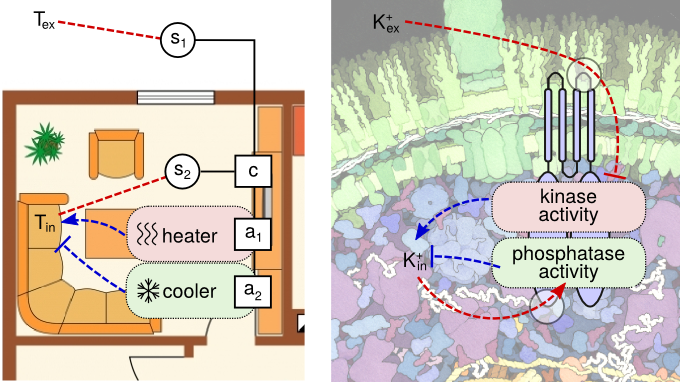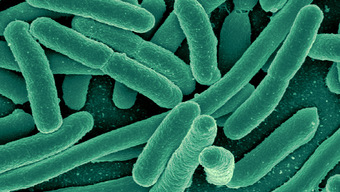Two sensors and a controller - all within a single protein molecule
2016-06-17 – News from the Physics Department

Potassium is essential for a variety of functions in living cells. Precise control of the potassium level within the cell is therefore vital for survival. Bacteria, such as the intestinal bacterium Escherichia coli must cope with the fact that the concentration of potassium in their environment is about a hundred times lower than in the cell and its availability can vary over a wide range. Furthermore, the cell’s demand for potassium varies as well.
LMU biologists led by Professor Kirsten Jung, in collaboration with physicists headed by Professor Ulrich Gerland at the Technical University of Munich (TUM), have now elucidated the mechanism by which the sensor protein KdpD adjusts the uptake of potassium cations. Strikingly, this receptor is capable of simultaneously sensing the concentration of free potassium ions present both inside and outside the cell.
With this dual strategy that is particularly advantageous in habitats where these parameters can be expected to vary often, the potassium sensor protein KdpD ensures that the intracellular concentration of potassium is maintained at the appropriate level. If the external potassium concentration is low, KdpD acts as a “kinase” to rapidly attach a phosphate group to the regulatory protein KdpE in the cell cytoplasm.
The phosphorylated form of KdpD in turn triggers the synthesis of a multicomponent transporter (KdpFABC), which mediates high-affinity uptake of potassium into the cell. On the other hand, when the cell is replete with potassium, KdpD functions as a so-called “phosphatase” and removes the phosphate group from KdpE, thus inactivating it and preventing the now superfluous production of the transporter.
The two-in-one sensor
KdpD is a transmembrane receptor – a protein that extends through the cytoplasmic membrane – and it carries two spatially-separated binding sites for potassium. One is located outside the cytoplasmic membrane and is accessible only to extracellular potassium, while the other is located on the other side of the membrane and interacts only with intracellular potassium.
Hence, the receptor can monitor the levels of the cation present on both sides of the plasma membrane. Jung and her colleagues have now shown that binding of potassium to the external recognition site results in inhibition of KdpD’s kinase activity. Furthermore, if the intracellular binding site is occupied then KpdD switches into its phosphatase mode.
“So the cell can activate synthesis of the potassium transporter not only when the external concentration of the cation is running low, but also when the cell’s demand for it rises – simply by tuning the ratio between kinase and phosphatase activities. This mechanism thus allows for precise control of the intracellular potassium level in the presence of fluctuations in both the availability of, and demand for, the ion,” Jung explains.
“We were completely surprised that nature has realized such a dual strategy in a single protein,” says Professor Ulrich Gerland. “We suspect that the integration of all functions in one single protein not only allows a more precise regulation, but makes the scheme even more robust. Hence the scheme works even if even if the number of regulator proteins varies over time. “
The researchers expect that other receptors controlling important physiological processes also employ this dual-action mechanism, and plan to identify and characterize more members of this class.
This work was supported by the Deutsche Forschungsgemeinschaft (DFG) within the Clusters of Excellence Center for integrated Protein Science Munich (CiPSM) Nanosystems Initiative Munich (NIM) and by a research fellowship of the Alexander von Humboldt Foundation.
- Editing
- Monika Gödde (LMU), Andreas Battenberg (TUM), Dr. Johannes Wiedersich
Publication
Links
Contact
- Prof. Dr. Ulrich Gerland
- Technische Universität MünchenJames-Franck-Str. 185748 GarchingTel.: +49 89 289-12380E-Mail: gerland@tum.de
